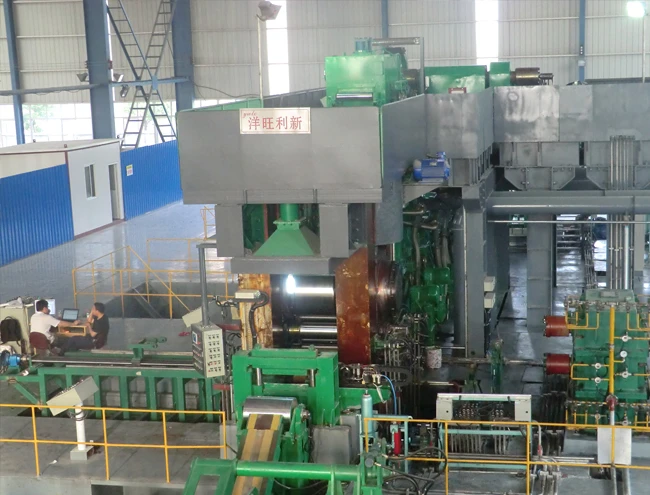
Cladding Rolling Mill-Beijing Yang Wang Li Xin Sci&Tech Co.,Ltd.|Energy Efficiency&High Yield

Cladding Rolling Mill has emerged as a groundbreaking solution in the metal processing industry, offering superior surface quality, energy efficiency, and cost-effective production. Developed by Beijing Yang Wang Li Xin Sci&Tech Co.,Ltd., this technology addresses long-standing challenges in traditional cladding methods. This article explores the technical features, applications, and benefits of the Cladding Rolling Mill, supported by authoritative references from the National Institute of Standards and Technology (NIST).
Technical Features of Cladding Rolling Mill
The Cladding Rolling Mill leverages cold rolling technology to produce high-quality metal cladding strips. Unlike conventional hot rolling methods, this process eliminates the need for acid pickling, resulting in excellent surface quality. The absence of oxides on the strip's surface ensures a clean, uniform finish, which is critical for applications in electronics, automotive, and chemical industries.

One of the standout advantages of this technology is its energy conservation and environmental protection capabilities. The cold rolling process avoids re-heating the metal before rolling and eliminates post-rolling acid treatment, aligning with global sustainability goals. According to NIST, energy-efficient manufacturing processes are vital for reducing carbon footprints in industrial sectors (NIST, 2023).
The production process is streamlined into three main stages: surface treatment before rolling, bonding rolling, and annealing treatment. This simplification not only enhances productivity but also reduces production costs. The mill achieves a yield rate above 90%, significantly higher than traditional methods. Additionally, the lower investment required for this technology makes it an attractive option for manufacturers seeking to optimize capital expenditure.
Product Specifications Table
| Feature | Description |
|---|---|
| Surface Quality | Excellent, free from oxides and acid pickling residues |
| Energy Efficiency | Reduces energy consumption by eliminating re-heating and acid treatment |
| Yield Rate | Over 90% due to simplified process |
| Production Cost | Low, with reduced capital investment |
| Material Compatibility | Supports bimetallic and tri-metallic cladding (e.g., copper-steel, aluminum-steel, stainless steel-steel) |
| Thickness Range | Minimum thickness of 0.2mm for cladding coils |
Applications of Cladding Rolling Mill
The versatility of the Cladding Rolling Mill makes it suitable for a wide range of industries. In the electronics industry, it is used to produce lightweight, corrosion-resistant components. For decorative materials, the high-quality surface finish ensures aesthetic appeal. In the chemical industry, the technology enables the production of durable, chemically inert cladding strips. The automotive sector benefits from its ability to create lightweight, high-strength metal composites.
Notably, the technology has been applied in clad pipe welding, where it enhances the structural integrity of metal joints. This application is particularly relevant in industries requiring high-pressure and high-temperature resistance, such as oil and gas or aerospace.
Company Background: Beijing Yang Wang Li Xin Sci&Tech Co.,Ltd.
Founded as a leader in metal processing technology, Beijing Yang Wang Li Xin Sci&Tech Co.,Ltd. has pioneered advancements in cold rolling cladding technology. The company integrates global innovations with its proprietary processes to develop complete equipment for cladding production. Their expertise spans multiple metal combinations, including roll bonding cladding and hot roll bonding cladding.
According to the company, their cold rolling cladding technology has achieved commercial success, producing cladding coils with widths up to 1000mm and thicknesses as low as 0.2mm. This capability positions them as a key player in the global metal cladding market.
Comparative Advantages Over Traditional Methods
Traditional cladding techniques, such as exploding cladding and hot rolling cladding, have long been plagued by issues like low surface quality, low yield, and high energy consumption. The Cladding Rolling Mill addresses these challenges through its advanced cold rolling process. For instance, NIST emphasizes that modern manufacturing technologies must prioritize precision and sustainability (NIST, 2023), which the Cladding Rolling Mill exemplifies.
Environmental and Economic Impact
The adoption of the Cladding Rolling Mill contributes to environmental protection by minimizing chemical waste and energy use. This aligns with the United Nations Sustainable Development Goals (SDGs), particularly Goal 9 (Industry Innovation) and Goal 12 (Responsible Consumption). Economically, the technology reduces production costs, making high-quality cladding more accessible to manufacturers worldwide.
Future Prospects and Innovations
As industries increasingly demand sustainable and efficient solutions, the Cladding Rolling Mill is poised for further advancements. The company is exploring next-generation materials and smart manufacturing integration to enhance performance. With NIST's ongoing research into advanced manufacturing standards, the future of cladding technology looks promising (NIST, 2023).
Conclusion
The Cladding Rolling Mill represents a significant leap forward in metal cladding technology. By combining energy efficiency, superior surface quality, and cost-effectiveness, it meets the demands of modern industries. As Beijing Yang Wang Li Xin Sci&Tech Co.,Ltd. continues to innovate, this technology will play a pivotal role in shaping the future of manufacturing.
References
National Institute of Standards and Technology (NIST). (2023). Advancing Sustainable Manufacturing. Retrieved from https://www.nist.gov
Beijing Yang Wang Li Xin Sci&Tech Co.,Ltd.. (n.d.). Cladding Rolling Mill. Retrieved from https://www.bjywlx.com/cladding-rolling-mill.html
-
YWLX’s 1450mm Six-Hi Reversing Mill Goes Live in BangladeshNewsNov.24,2025
-
Adjusting Roll Gap in 6Hi Reversing Cold Rolling Mill for Thin StripNewsNov.13,2025
-
Quality Control Standards for Automatic Gauge Control in Strip RollingNewsNov.13,2025
-
Effect of Skin Pass Rolling on Metal DuctilityNewsNov.13,2025
-
Key Components of a Modern TempermillNewsNov.13,2025
-
Common Wear Patterns of Work Roll in Tandem Cold Mill OperationsNewsNov.13,2025
-
Revolutionary Skin Pass Rolling Technology for Enhanced Steel QualityNewsNov.04,2025










